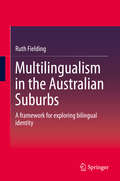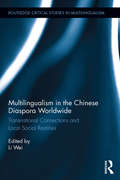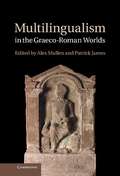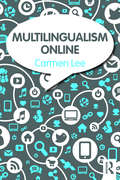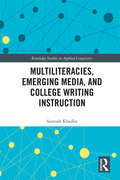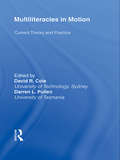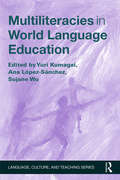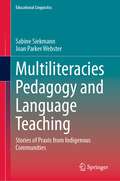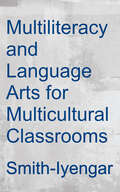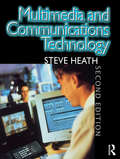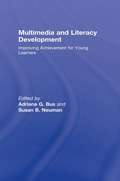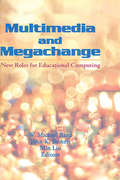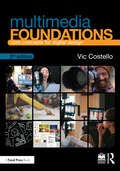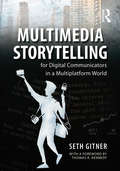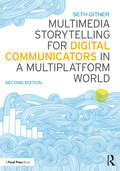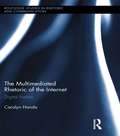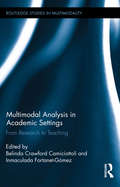- Table View
- List View
Multilingualism in the Australian Suburbs
by Ruth FieldingThis book introduces a framework for examining bilingual identity and presents the cases of seven individual children from a study of young students' bilingual identities in an Australian primary school. The new Bilingual Identity Negotiation Framework brings together three elements that influence bilingual identity development - sociocultural connection, investment and interaction. The cases comprise individual stories about seven young, bilingual students and are complemented by some more general investigations of bilingual identity from a whole class of students at the school. The framework is explained and supported using the students' stories and offers readers a new concept for examining and thinking about bilingual identity. This book builds upon past and current theories of identity and bilingualism and expands on these to identify three interlinking elements within bilingual identity. The book highlights the need for greater dialogue between different sectors of research and education relating to languages and bilingualism. It adds to the increasing call for collaborative work from the different fields interested in language learning and teaching such as TESOL, bilingualism, and language education. Through the development of the framework and the students' stories in this study, this book shows how multilingual children in one school in Australia developed their identities in association with their home and school languages. This provides readers with a model for examining bilingual identity in their own contexts, or a theoretical construct to consider in their thinking on bilingualism, language and identity.
Multilingualism in the Baltic States: Societal Discourses And Contact Phenomena
by Sanita Lazdiņa Heiko F. MartenThis edited collection provides an overview of linguistic diversity, societal discourses and interaction between majorities and minorities in the Baltic States. It presents a wide range of methods and research paradigms including folk linguistics, discourse analysis, narrative analyses, code alternation, ethnographic observations, language learning motivation, languages in education and language acquisition. Grouped thematically, its chapters examine regional varieties and minority languages (Latgalian, Võro, urban dialects in Lithuania, Polish in Lithuania); the integration of the Russian language and its speakers; and the role of international languages like English in Baltic societies. The editors’ introductory and concluding chapters provide a comparative perspective that situates these issues within the particular history of the region and broader debates on language and nationalism at a time of both increased globalization and ethno-regionalism. This book will appeal in particular to students and scholars of multilingualism, sociolinguistics, language discourses and language policy, and provide a valuable resource for researchers focusing on Baltic States, Northern Europe and the post-Soviet world in the related fields of history, political science, sociology and anthropology.
Multilingualism in the Chinese Diaspora Worldwide: Transnational Connections and Local Social Realities (Routledge Critical Studies in Multilingualism)
by Li WeiIn this volume, Li Wei brings together contributions from well-known and emerging scholars in socio- and anthropological linguistics working on different linguistic and communicative aspects of the Chinese diaspora. The project examines the Chinese diasporic experience from a global, comparative perspective, with a particular focus on transnational links, and local social and multilingual realities. Contributors address the emergence of new forms of Chinese in multilingual contexts, family language policy and practice, language socialization and identity development, multilingual creativity, linguistic attitudes and ideologies, and heritage language maintenance, loss, learning and re-learning. The studies are based on empirical observations and investigations in Chinese communities across the globe, including well-researched (from a sociolinguistic perspective) areas such as North America, Western Europe and Australia, as well as under-explored and under-represented areas such as Africa, Latin America, Central Asia, and the Middle East; the volume also includes detailed ethnographic accounts representing regions with a high concentration of Chinese migration such as Southeast Asia. This volume not only will allow sociolinguists to investigate the link between linguistic phenomena in specific communities and wider socio-cultural processes, but also invites an open dialogue with researchers from other disciplines who are working on migration, diaspora and identity, and those studying other language-based diasporic communities such as the Russian diaspora, the Spanish diaspora, the Portuguese diaspora, and the Arabic diaspora.
Multilingualism in the Graeco-Roman Worlds
by Alex Mullen Patrick JamesThrough words and images employed both by individuals and by a range of communities across the Graeco-Roman worlds, this book explores the complexity of multilingual representations of identity. Starting with the advent of literacy in the Mediterranean, it encompasses not just the Greek and Roman empires but also the transformation of the Graeco-Roman world under Islam and within the medieval mind. By treating a range of materials, contexts, languages, and temporal and political boundaries, the contributors consider points of cross-cultural similarity and difference and the changing linguistic landscape of East and West from antiquity into the medieval period. Insights from contemporary multilingualism theory and interdisciplinary perspectives are employed throughout to exploit the material fully.
Multilingualism Online
by Carmen LeeBy the co-author of Language Online, this book builds on the earlier work while focusing on multilingualism in the digital world. Drawing on a range of digital media – from email to chatrooms and social media such as Facebook, Instagram, and YouTube – Lee demonstrates how online multilingualism is closely linked to people's offline literacy practices and identities, and examines the ways in which people draw on multilingual resources in their internet participation. Bringing together central concepts in sociolinguistics and internet linguistics, the eight chapters cover key issues such as: language choice code-switching identities language ideologies minority languages online translation. Examples in the book are drawn from both all the major languages and many lesser-written ones such as Chinese dialects, Egyptian Arabic, Irish, and Welsh. A chapter on methodology provides practical information for students and researchers interested in researching online multilingualism from a mixed methods and practice-based approach. Multilingualism Online is key reading for all students and researchers in the area of multilingualism and new media, as well as those who want to know more about languages in the digital world.
Multiliteracies: Literacy Learning And Design Of Social Futures (Literacies)
by Bill Cope Mary KalantzisMultiliteracies considers the future of literacy teaching in the context of the rapidly changing English language. Questions are raised about what constitutes appropriate literacy teaching in today's world: a world that is both a global village yet one which local diversity is increasingly important. This is a coherent and accessible overview of the work of the New London Group, with well-known international contributors bringing together their varying national experiences and differences of theoretical and political emphasis. The essays deal with issues such as: the fundamental premises of literacy pedagogy the effects of technological change multilingualism and cultual diversity social futures and their implications on language teaching. The book concludes with case studies of attempts to put the theories into practice and thereby provides a basis for dialogue with fellow educators around the world.
Multiliteracies, Emerging Media, and College Writing Instruction (Routledge Research in Language and Communication)
by Santosh KhadkaThis book proposes a broad-based multiliteracies theory and praxis for college writing curriculum. Khadka expands on the work of the New London Group’s theory of multiliteracies by integrating work from related disciplinary fields such as media studies, intercultural communication, World Englishes, writing studies, and literacy studies to show how they might be brought together to aid in designing curriculum for teaching multiple literacies, including visual, digital, intercultural, and multimodal, in writing and literacy classes. Building on insights developed from qualitative analysis of data from the author’s own course, the book examines the ways in which diverse groups of students draw on existing literacy practices while also learning to cultivate the multiple literacies, including academic, rhetorical, visual, intercultural, and multimodal, needed in mediating the communication challenges of a globalized world. This approach allows for both an exploration of students’ negotiation of their cultural, linguistic, and modal differences and an examination of teaching practices in these classrooms, collectively demonstrating the challenges and opportunities afforded by a broad-based multiliteracies theory and praxis. This book will be of particular interest to scholars and researchers in writing studies, rhetoric and communication studies, multimodality, media studies, literacy studies, and language education.
Multiliteracies for a Digital Age
by Stuart A. SelberThis is a guide for composition teachers to develop effective, full-scale computer literacy programs that are also professionally responsible by emphasizing different kinds of literacies and proposing methods for helping students move among them in strategic ways.
Multiliteracies in Motion: Current Theory and Practice
by David R. Cole Darren Lee PullenThe realities of new technological and social conditions since the 1990s demand a new approach to literacy teaching. Looking onward from the original statement of aims of the multiliteracies movement in 1996, this volume brings together top-quality scholarship and research that has embraced the notion and features new contributions by many of the originators of this approach to literacy. Drawing on large research projects and empirical evidence, the authors explore practical and educational issues that relate to multiliteracies, such as assessment, pedagogy and curriculum. The viewpoint taken is that multiliteracies is a complementary socio-cultural approach to the new literacies that includes pedagogy and learning. The differences are addressed from a multiliteracies perspective – one that does not discount or undermine the new literacies, but shows new ways in which they are complementary. Computers and the internet are transforming the way we work and communicate and the very notion of literacy itself. This volume offers frontline information and a vital update for those wishing to understand the evolution of multiliteracies and the current state of literacy theory in relation to it.
Multiliteracies in World Language Education (Language, Culture, and Teaching Series)
by Yuri Kumagai Ana López-Sánchez Sujane WuPutting a multiliteracies framework at the center of the world language curriculum, this volume brings together college-level curricular innovations and classroom projects that address differences in meaning and worldviews expressed in learners’ primary and target languages. Offering a rich understanding of languages, genres, and modalities as socioculturally situated semiotic systems, it advocates an effective pedagogy for developing learners’ abilities to operate between languages. Chapters showcase curricula that draw on a multiliteracies framework and present various classroom projects that develop aspects of multiliteracies for language learners. A discussion of the theoretical background and historical development of the pedagogy of multiliteracies and its relevance to the field of world language education positions this book within the broader literature on foreign language education. As developments in globalization, accountability, and austerity challenge contemporary academia and the current structure of world language programs, this book shows how the implementation of a multiliteracies-based approach brings coherence to language programs, and how the framework can help to accomplish the goals of higher education in general and of language education in particular.
Multiliteracies Pedagogy and Language Teaching: Stories of Praxis from Indigenous Communities (Educational Linguistics #60)
by Sabine Siekmann Joan Parker WebsterThis volume offers an approach to language and literacy instruction that brings together theoretical concepts of multiliteracies and second language acquisition. This approach is illustrated through examples of innovative teacher-generated action research conducted in Indigenous and English, dual language and immersion classrooms, all situated in the context of language and cultural maintenance and revitalization. These examples of praxis help to bridge the gap between theory and practice in Indigenous language and literacy teaching. The volume draws on critical theories of praxis and the concept of multiliteracies and multimodalities, with specific attention to the design cycle as a way to conceptualize and engage in praxis through research and pedagogy. The authors trace teacher trajectories relating to (language) teaching and their positionalities in language revitalization and maintenance efforts by using a participatory teacher action research approach. The final chapter brings together Indigenous and western onto-epistemological and methodological perspectives in a conversation among two western and an Indigenous scholar, who have been working together with the teacher-researchers whose stories are presented in this volume. This volume is of interest to scholars, graduate students, educational practitioners and educational leaders interested in multiliteracies, multimodalities, teacher action research, and Indigenous pedagogies.
Multiliteracy and Language Arts for Multicultural Classrooms
by Howard Leslie Smith Kalpana Mukunda IyengarAs schools receive increasing numbers of children from diverse backgrounds, teachers are challenged to offer meaningful instruction to scaffold their reading and writing development. The chapters in this volume feature asset-based approaches to literacy instruction. Readers will discover chapters informed by critical frameworks: The Community Cultural Wealth model (Yosso, 2005), the findings from the Funds of Knowledge (Moll, et al., 1992), and the contributions of Multicultural Children's Literature (Iwai, 2019) for culturally efficacious instruction and cultural preservation (Iyengar & Smith, 2016). Irrespective of content area, all educators contribute to the literacy development of all students. However, not all teachers are equally skilled in appropriate (i.e., asset-based) instructional delivery for linguistically and culturally diverse classrooms. Literacy instruction that embraces multiple perspectives should not be limited to the Language Arts curriculum. Culturally efficacious literacy practices (Flores, et al., 2018) benefit all students in all subject areas. Whether a mainstream, multilingual, bilingual, Dual Language, or ESL classroom, opportunities for literacy explorations from divergent perspectives can be embedded throughout the curriculum if the teacher actively embraces diversity.
Multimedia and Communications Technology
by Steve HeathMultimedia and Communications Technology is a practical explanation of the technologies that bring together existing products such as the PC, telephone and television. It is precisely this revolution that the book addresses - offering an up to date technical overview of developments in PC technology, video and audio compression, telecommunications and many other disciplines. Written as a series of tutorials, the book starts with the fundamental techniques of digital audio and video, moving on to compression techniques such as JPEG and MPEG. The delivery systems for multimedia are then covered, starting with the CD and on to telephones, local and wide area networks and ATM and ASDL. The final chapters describe how these technologies are brought together in some key applications:· video conferencing· digital video broadcasting· video on demand · interactive televisionSteve Heath is responsible for European Strategy and Technology Development at Motorola. He has had many years experience in computer design and has presented papers on multimedia technology at international conferences. He is a well known technical writer and has written fourteen other books for Focal Press, Newnes and Butterworth-Heinemann.
Multimedia and Literacy Development: Improving Achievement for Young Learners
by Susan B. Neuman Adriana G. BusRepresenting the state of the art in multimedia applications and their promise for enhancing early literacy development, this volume broadens the field of reading research by looking beyond print-only experiences to young readers’ encounters with multimedia stories on the Internet and DVD. Multimedia storybooks include, in addition to static pictures and written text, features such as oral text, animations, sounds, zooms, and scaffolds designed to help convey meaning. These features are changing how young children read text, and also provide technology-based scaffolds for helping struggling readers. Multimedia and Literacy Development reports experimental research and practices with multimedia stories indicating that new dimensions of media contribute to young children’s ability to understand stories and to read texts independently. This is the first synthesis of evidence-based research in this field. Four key themes are highlighted: Understanding the multimedia environment for learning Designing multimedia applications for learning New approaches to storybook reading Multimedia applications in classroom instruction. Written in jargon-free language for an international audience of students in university courses on literacy and information technology, researchers, policymakers, program developers, and media specialists, this volume is essential reading for all professionals interested in early literacy and early interventions.
Multimedia and Megachange: New Roles for Educational Computing
by W Michael Reed John K BurtonThe use of multimedia strikes at the very heart of traditional teaching and learning methods, and is changing the way educators think about the whole process of teaching and learning. Multimedia and Megachange spurs ideas for the use of interactive technology to revolutionize teaching and learning. It describes and analyzes issues and trends that are currently setting a research and development agenda for educators.Contributors to this volume explore all fronts on which computer technology are changing the educational process:concept and theoryresearchapplicationdesignMultimedia and Megachange opens up the exciting world of how technology is dramatically changing how teachers teach and students learn. It also highlights spin-off changes for classroom management, greater sources of information, and improved evaluation and grading techniques.
Multimedia Foundations
by Vic CostelloUnderstand the core concepts and skills of multimedia production and digital storytelling using text, graphics, photographs, sound, motion, and video. Then, put it all together using the skills that you have developed for effective project planning, collaboration, visual communication, and graphic design. Presented in full color with hundreds of vibrant illustrations, "Multimedia Foundations" trains you in the principles and skill sets common to all forms of digital media production, enabling you to create successful, engaging content, no matter what tools you are using. Companion website features a wealth of web resources, illustrations, and video tutorials demonstrating the key techniques presented in the book. Improve projects with core principles of visual communication and graphic design. Learn necessary strategies for project planning, organization, and asset management. Understand the intricacy of design and production workflows. Effectively navigate postproduction and the distribution of multimedia content. Utilize the companion web site video tutorials and links to go along with each of the chapters.
Multimedia Foundations
by Vic CostelloUnderstand the core concepts and skills of multimedia production and digital storytelling using text, graphics, photographs, sound, motion, and video. Then, put it all together using the skills that you have developed for effective project planning, collaboration, visual communication, and graphic design. Presented in full color with hundreds of vibrant illustrations, "Multimedia Foundations" trains you in the principles and skill sets common to all forms of digital media production, enabling you to create successful, engaging content, no matter what tools you are using. Companion website features a wealth of web resources, illustrations, and video tutorials demonstrating the key techniques presented in the book. Improve projects with core principles of visual communication and graphic design. Learn necessary strategies for project planning, organization, and asset management. Understand the intricacy of design and production workflows. Effectively navigate postproduction and the distribution of multimedia content. Utilize the companion web site video tutorials and links to go along with each of the chapters.
Multimedia Foundations: Core Concepts for Digital Design
by Vic CostelloUnderstand the core concepts and skills of multimedia production and digital storytelling using text, graphics, photographs, sound, motion, and video. Then, put it all together using the skills that you have developed for effective project planning, collaboration, design, and production. Presented in full color with hundreds of vibrant illustrations, Multimedia Foundations, Second Edition trains you in the principles and skill sets common to all forms of digital media production, enabling you to create successful, engaging content, no matter what tools you are using. The second edition has been fully updated and features a new chapter on video production and new sections on user-centered design, digital cinema standards (2K, 4K, and 8K video), and DSLR and video camcorder recording formats and device settings. The companion website, which features a wealth of web resources, glossary terms, and video tutorials, has also been updated with new content for both students and instructors.
Multimedia Foundations: Core Concepts for Digital Design
by Vic CostelloWhether you are working using text, graphics, photography, sound, motion, or video, Multimedia Foundations covers the skills necessary to be an effective modern storyteller. Presented in full color with hundreds of vibrant illustrations, this book trains readers in the principles and skills common to all forms of digital media production, enabling the creation of successful, engaging content, no matter what tools are used. Chapters feature useful exercises to cement core concepts and help readers develop planning, collaboration, design, and production skills. This third edition has been fully updated and includes new and revised illustrations, updated coverage of digital asset management and media workflows, a completely rewritten chapter on coding for web and mobile media, and new sections on design thinking, inclusive design, color theory, photography composition, interview and B-roll acquisition techniques, and editing stages and postproduction workflows. Multimedia Foundations is a comprehensive resource for students in fields such as journalism, film production, animation and game design, web and graphic design, and other areas where modern media is produced. A website with Instructor and Student Resources for this book includes a glossary of terms, chapter PowerPoints, and sample text banks.
Multimedia Reporting: How Digital Tools Can Improve Journalism Storytelling (Tsinghua Global Business Journalism Series)
by Richard Scott DunhamThis is the first book to apply multimedia tools to economic and business storytelling. By examining the journalism essentials as well as the advanced multimedia skills, it helps readers use the latest technological tools to integrate multimedia elements into traditional news coverage. It also explains how to tell stories solely through multimedia elements. The new language of online journalism includes writing for digital platforms, writing blogs and writing for social media and involves a wide range of multimedia skills, like video, audio, photography, graphics, data visualization and animation. Multimedia journalism allows a two-way communication with the audience that was not possible in traditional “legacy” media, and this textbook is replete with links to useful tutorials, examples of award-winning multimedia stories, and advanced digital resources, offering journalists a road map to the brave new world of digital reporting and editing.
Multimedia Storytelling for Digital Communicators in a Multiplatform World
by Seth GitnerMultimedia Storytelling for Digital Communicators in a Multiplatform World is a unique guide for all students who need to master visual communication through multiple media and platforms. Every communication field now requires students to be fluent in visual storytelling skill sets, and as the present-day media adapt to a multiplatform world (with ever-increasing delivery systems from desktops to cell phones), students specializing in different forms of communication are discovering the power of merging new multimedia technology with very old and deep-rooted storytelling concepts. Award-winning journalist and multimedia professor Seth Gitner provides students with the tools for successfully realizing this merger, from understanding conflict, characters, and plot development to conducting successful interviews, editing video in post-production, and even sourcing royalty-free music and sound effects. Incorporating how-to’s on everything from website and social media optimization to screenwriting, Multimedia Storytelling aims to be a resource for any student who needs to think and create visually, in fields across broadcast and digital journalism, film, photography, advertising, and public relations. The book also includes a range of supplemental material, including wide-ranging skills exercises for each chapter, interviews with seasoned professionals, key terms, and review questions.
Multimedia Storytelling for Digital Communicators in a Multiplatform World
by Seth GitnerNow in its second edition, Multimedia Storytelling for Digital Communicators in a Multiplatform World is a trusted guide for all students who need to master visual communication through multiple media and platforms. Incorporating how-to’s on everything from website and social media optimization to screenwriting, this textbook provides readers with the tools for successfully merging new multimedia technology with very old and deep-rooted storytelling concepts. Topics covered include: how to understand conflict, characters, and plot development; conducting successful interviews; editing video in post-production; and sourcing royalty-free music and sound effects. The book also includes a range of supplemental material, including exercises for each chapter, interviews with seasoned professionals, key terms, and review questions. New to this edition are thoroughly updated chapters on social media storytelling, visual storytelling with mobile devices, and post-production techniques, to reflect current industry trends. This book is a key resource for students learning to think and create visually in fields across broadcast and digital journalism, film, photography, advertising, and public relations.
The Multimediated Rhetoric of the Internet: Digital Fusion (Routledge Studies in Rhetoric and Communication #10)
by Carolyn HandaThis project is a critical, rhetorical study of the digital text we call the Internet, in particular the style and figurative surface of its many pages as well as the conceptual, design patterns structuring the content of those same pages. Handa argues that as our lives become increasingly digital, we must consider rhetoric applicable to more than just printed text or to images. Digital analysis demands our acknowledgement of digital fusion, a true merging of analytic skills in many media and dimensions. CDs, DVDs, and an Internet increasingly capable of streaming audio and video prove that literacy today means more than it used to, namely the ability to understand information, however presented. Handa considers pedagogy, professional writing, hypertext theory, rhetorical studies, and composition studies, moving analysis beyond merely "using" the web towards "thinking" rhetorically about its construction and its impact on culture. This book shows how analyzing the web rhetorically helps us to understand the inescapable fact that culture is reflected through all media fused within the parameters of digital technology.
Multimodal Analysis in Academic Settings: From Research to Teaching (Routledge Studies in Multimodality)
by Belinda Crawford Camiciottoli Inmaculada Fortanet-GómezThis volume presents innovative research on the multimodal dimension of discourse specific to academic settings, with a particular focus on the interaction between the verbal and non-verbal in constructing meaning. Contributions by experienced and emerging researchers provide in-depth analyses in both research and teaching contexts, and consider the ways in which multimodal strategies can be leveraged to enhance the effectiveness of academic communication. Contributors employ both quantitative and qualitative analytical methods, and make use of state-of-the-art software for analyzing multimodal features of discourse. The chapters in the first part of the volume focus on the multimodal features of two key research genres: conference presentations and plenary addresses. In the second part, contributors explore the role of multimodality in the classroom through analyses of both instructors’ and students’ speech, as well as the use of multimodal materials for more effective learning. The research presented in this volume is particularly relevant within the context of globalized higher education, where participants represent a wide range of linguistic and cultural backgrounds. Multimodal Analysis in Academic Settings contributes to an emerging field of research with importance to an increasing number of academics and practitioners worldwide.
A Multimodal and Ethnographic Approach to Textbook Discourse (Routledge Studies in Multimodality)
by Germán CanaleThis book offers a new framework for analysing textbook discourse, bridging the gap between contemporary ethnographic approaches and multimodality for a contextually sensitive approach which considers the multiplicity of multimodal resources involved in the production and use of textbooks. The volume makes the case for textbook discourse studies to go beyond studies of textual representation and critically consider the ways in which textbook discourse is situated within wider social practices. Each chapter considers a different social semiotic practice in which textbook and textbook discourse is involved: representation, communication, interaction, learning, and recontextualization. In bringing together this work with contemporary ethnography scholarship, the book offers a comprehensive toolkit for further research on textbook discourse and pushes the field forward into new directions. This innovative book will be of particular interest to students and scholars in discourse analysis, multimodality, social semiotics, language and communication, and curriculum studies.
